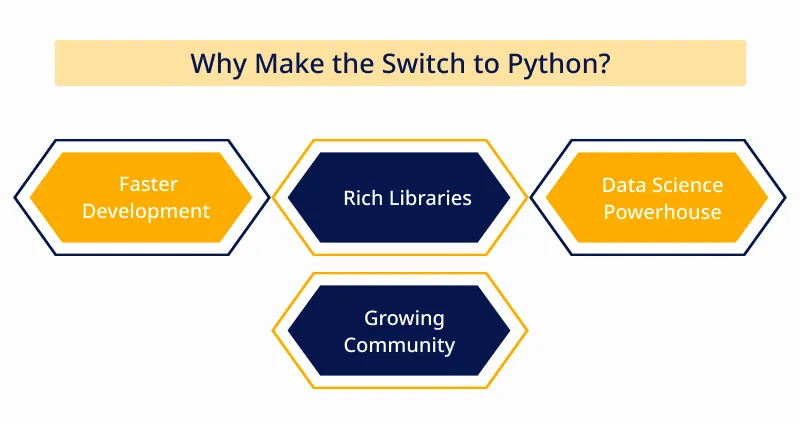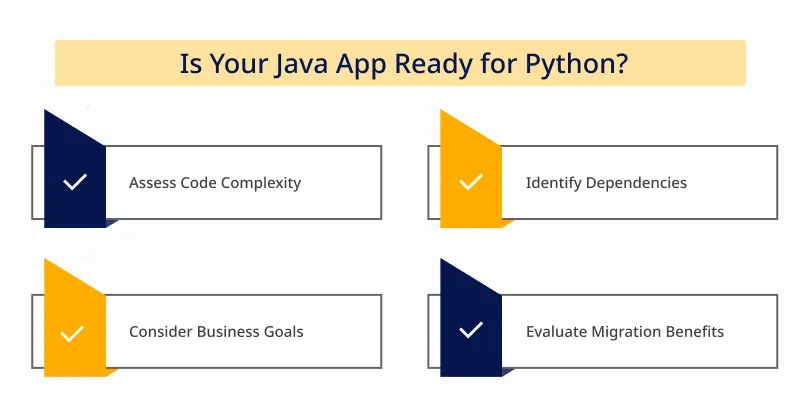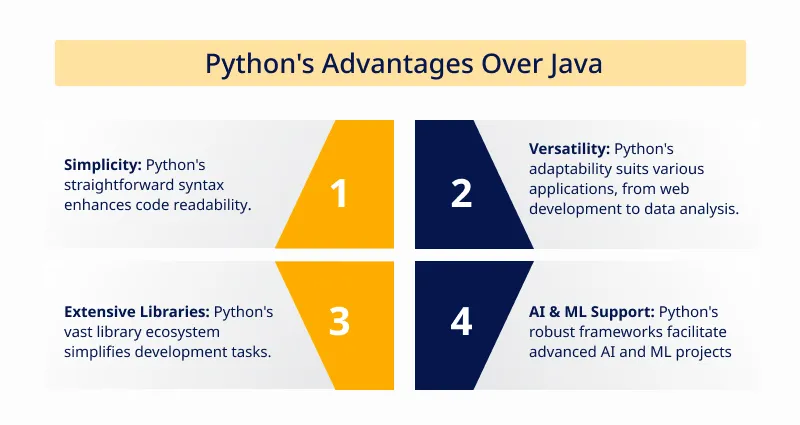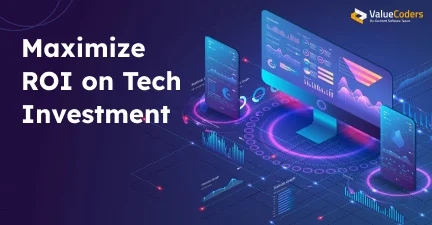Quick Overview
In this comprehensive guide, you’ll learn how to efficiently migrate your Java applications to Python for modernization. This blog post outlines strategic approaches for a smooth transition, covering key topics such as Python migration tips and efficient IT migration strategies. You’ll find out why Python is increasingly preferred over Java with some success stories of successful migrations. Additionally, we have also shared the valuable resources and tools in this post for your easy migration journey. Whether you’re seeking faster development, cloud-native readiness, or leveraging Python’s data science capabilities, this guide provides actionable insights to help you navigate the migration process effectively.
Have you ever felt like your Java applications are starting to feel outdated?
With new languages like Python gaining popularity, you may wonder if it’s time to modernize.
According to the latest Stack Overflow Developer Survey, Python is the third most-loved programming language worldwide, showcasing its popularity among developers.
As a result, the increasing demand for Python developers across various industries surpasses the demand for Java developers in many regions.
With this rise, more and more businesses are planning to migrate from Java to Python and seeking guidance from Top Java Development Companies.
Migrating from Java to Python can seem daunting, but it doesn’t have to be!
This blog post will discuss a strategic approach to migrating your legacy Java codebase to modern Python. Python’s increased productivity and a large ecosystem of open-source libraries have made it a go-to language for many developers today.
We’ll cover when it makes sense to migrate, how to prepare your codebase, porting considerations, and best practices for a successful migration.
By the end, you’ll understand the key technical and organizational steps when moving from Java to Python. This will allow you to take advantage of Python’s benefits, like improved readability and reduced code verbosity.
Whether you want to scale faster, leverage new technologies like machine learning, or improve developer productivity, a strategic migration from Java to Python may suit your needs
Let’s begin!
Why Migrate from Java to Python?
Migrating from Java to Python offers numerous advantages that can significantly improve your development process and overall project outcomes. Insights from the RedMonk Programming Language Rankings reveal a downward trend in Java’s popularity over the past few years, while Python continues to rise steadily.
Here’s why making the switch is a smart move:
- Faster Development: Python’s concise syntax and extensive library support enable developers to write code faster than Java. With Python, you can achieve rapid prototyping and iterate on your ideas faster, saving time and effort in the development cycle.
- Cloud-Native Readiness: Python is well-suited for modern cloud-native architectures and DevOps practices. Its flexibility and scalability make building and deploying microservices easier, ensuring your applications are ready to thrive in cloud environments.
- Data Science and AI Capabilities: Python has emerged as the go-to language for data science, machine learning, and artificial intelligence projects. Its rich ecosystem of libraries like NumPy, Pandas, and TensorFlow makes it easier to implement complex algorithms and analyze large datasets.
- Growing Talent Pool: With the increasing popularity of Python, there’s a vast community of developers proficient in the language. This means easier recruitment and access to expertise when building and maintaining your applications.
Leveraging Java to Python migration strategies can deliver these benefits and position your projects for success. Adopting a strategic migration approach ensures a smooth transition while maximizing the advantages of Python’s ecosystem.
Whether you’re a Java Web Application Development Company looking to modernize your tech stack or a team seeking to streamline development processes, migrating to Python opens up new opportunities for innovation and efficiency. Embrace the change and propel your projects forward with the power of Python.
ValueCoders' Java to Python migration services unlock new opportunities for growth.
Strategic Approach to Migration
When planning a Java to Python migration, a strategic approach is essential to ensure a smooth and successful transition. Everything needs the right strategy for implementation, from assessment to rollout and monitoring. If needed, hire Python developers in your team who are skilled and experienced in the migration process.
Here’s a detailed breakdown of the key steps involved in a strategic migration plan:
1. Assessment
Before beginning the migration process, conducting a comprehensive assessment of your existing Java codebase and infrastructure is crucial. This assessment involves analyzing factors such as code complexity, dependencies, and potential challenges that may arise during the migration process. By understanding the scope and intricacies of your project upfront, you can better prepare for the migration journey ahead.
- Evaluate code complexity and identify any potential roadblocks.
- Assess dependencies on third-party libraries and frameworks.
- Evaluate the impact of the migration on existing integrations and workflows.
2. Prioritization
Once you’ve assessed your codebase, prioritize which components to migrate first based on factors such as business criticality and complexity. Starting with smaller, less complex modules allows you to gain early wins and build momentum for the larger migration effort.
- Identify critical components that are essential for initial migration.
- Prioritize modules with minimal dependencies or external integrations.
- Consider starting with non-customer-facing functionalities to minimize disruption.
Also read: Python Vs Java: Which Is Best For Your Business App Development?
3. Selection of Tools and Techniques
Choose the right tools and techniques to facilitate the migration process. While automatic migration tools are available, some parts of the migration may require manual intervention. Additionally, consider leveraging Python development services to supplement your in-house expertise and ensure a smooth transition.
- Explore automatic migration tools such as Py4J or Jython for converting Java code to Python.
- Utilize manual refactoring techniques for more complex code segments.
- Consider hiring Python development services to provide expert guidance and support throughout migration.
4. Testing and Validation
Rigorous testing is essential at every stage of the migration process to ensure the correctness and functionality of the migrated code. Develop a comprehensive testing strategy encompassing unit, integration, and system testing to detect and address any issues early on.
- Create test cases to validate the functionality of the migrated code.
- Perform regression testing to ensure that existing features remain intact.
- Implement continuous integration and continuous deployment (CI/CD) pipelines to automate testing and validation processes.
5. Gradual Rollout and Monitoring
Rather than deploying the entire migrated codebase immediately, opt for a gradual rollout strategy to minimize risk and allow for iterative improvements. Observe the performance and stability of the migrated application closely, gathering feedback from users and stakeholders to inform future iterations.
- Deploy migrated components in stages, starting with less critical functionalities.
- Monitor application performance and user feedback to identify any issues or areas for improvement.
- Iterate on the migration process based on feedback and lessons learned from each deployment.
By following this strategic approach to Java to Python migration, you can minimize disruption, mitigate risks, and maximize the benefits of transitioning to Python.
Whether comparing Python vs. JavaScript or exploring Python development services, a well-planned migration strategy sets the foundation for a successful modernization journey.
Learn how ValueCoders can transform your legacy Java applications into Python-powered solutions.
The Python Advantage: Business Success Stories
Let’s discuss how various organizations have leveraged this transition to drive innovation, streamline operations, and gain a competitive edge.
Through these stories, you’ll learn the transformative power of Python in diverse industries, from e-commerce giants to healthcare providers, illustrating the tangible benefits of migrating from Java.
Story 1: The Tech Startup’s Journey to Innovation
A burgeoning tech startup faced scalability challenges with its Java-based platform. They needed a more agile solution to keep pace with their rapidly evolving market.
Migration Journey
The startup migrated its platform from Java to Python, seeking the expertise of one of the top Python development companies. Here’s how their migration journey unfolded:
- Strategic Planning: The startup collaborated with the Python development company to create a comprehensive migration plan tailored to their needs and goals.
- Seamless Migration: Leveraging the expertise of experienced Python developers, the migration process was executed smoothly, minimizing downtime and disruptions to the platform.
- Enhanced Performance: With Python’s flexibility and efficiency, the platform experienced a significant boost in performance, allowing the startup to handle increased user traffic and data processing more effectively.
- Innovative Features: Freed from the constraints of Java, the development team introduced innovative features and functionalities to the platform, enhancing user experience and driving engagement.
Results
- Increased Agility: The migration to Python empowered the startup to iterate on their platform more quickly, enabling them to maintain a leading position in the competition in their rapidly evolving market.
- in their rapidly evolving market.
- Cost Savings: The startup realized significant cost savings compared to maintaining its Java-based infrastructure by streamlining development processes and leveraging Python’s extensive libraries.
- Talent Acquisition: With access to a larger pool of Python developers, the startup was able to hire top talent to drive innovation and growth further.
Also read:10 Ways Python Development Can Benefit Your Business
Story 2: The Enterprise’s Digital Transformation
An established enterprise sought to modernize its legacy Java applications to meet evolving business needs and market demands.
Migration Journey
The enterprise embarked on a Java to Python migration journey, partnering with a reputable Python development company to guide them through the process:
- Strategic Assessment: Working closely with the Python development company, the enterprise thoroughly assessed their existing Java applications to identify opportunities for optimization and improvement.
- Customized Solutions: The Python development company tailored solutions to the enterprise’s unique requirements, leveraging Python’s versatility to build custom modules and integrations.
- Scalability and Flexibility: The enterprise gained the scalability and flexibility needed to adapt to changing market conditions and customer preferences by migrating to Python.
- Streamlined Operations: With Python’s intuitive syntax and extensive ecosystem, the enterprise streamlined its development operations, reducing time to market for new features and updates.
Results
- Enhanced Efficiency: The migration to Python resulted in streamlined development processes and increased productivity across the organization, allowing the enterprise to deliver value to customers more rapidly.
- Improved Customer Experience: With a more agile and responsive platform, the enterprise delivered a superior customer experience, driving customer satisfaction and loyalty.
- Competitive Advantage: By embracing Python and modernizing its technology stack, the enterprise gained a competitive edge, positioning itself for long-term success and growth.
These success stories underscore the transformative impact of Java to Python migration, showcasing how organizations can unlock new opportunities for innovation, efficiency, and growth.
Whether you’re a tech startup seeking agility or an enterprise pursuing digital transformation, migrating to Python opens up a world of possibilities for your business.
Also read: Know All-New Digital Transformation Strategies & Benefits For Your Business
Story 3: The E-commerce Giant’s Evolution
A leading e-commerce giant faced challenges with its outdated Java-based platform, which hindered its ability to innovate and scale in response to changing market dynamics.
Migration Journey
Determined to revitalize its platform, the e-commerce giant considered a Java-to-Python migration journey with the support of a top Python development company:
- Comprehensive Evaluation: The e-commerce giant thoroughly evaluated their existing Java platform, identifying areas for improvement and opportunities for innovation.
- Strategic Collaboration: Collaborating closely with the Python development company, the e-commerce giant devised a strategic migration plan tailored to their unique requirements and business objectives.
- Smooth Transition: Leveraging the expertise of experienced Python developers, the migration process was executed seamlessly, with minimal disruption to the platform’s operations.
- Enhanced Features: Freeding from the constraints of Java, the development team introduced a range of innovative features and enhancements to the platform, enriching the user experience and driving customer engagement.
Results
- Agility and Scalability: The migration to Python enabled the e-commerce giant to respond more swiftly to market changes and scale its platform to accommodate growing customer demand.
- Improved Performance: With Python’s efficiency and versatility, the platform experienced improved performance and reliability, enhancing the overall user experience and driving customer satisfaction.
- Competitive Edge: By embracing Python and modernizing their technology stack, the e-commerce giant gained a competitive edge in the highly competitive e-commerce market, positioning itself for continued success and growth.
ValueCoders' Java to Python migration services provide a seamless transition.
Beat Migration Hurdles: Top Resources & Tools
Are you ready to equip yourself with the right resources and tools for a successful Java-to-Python migration? 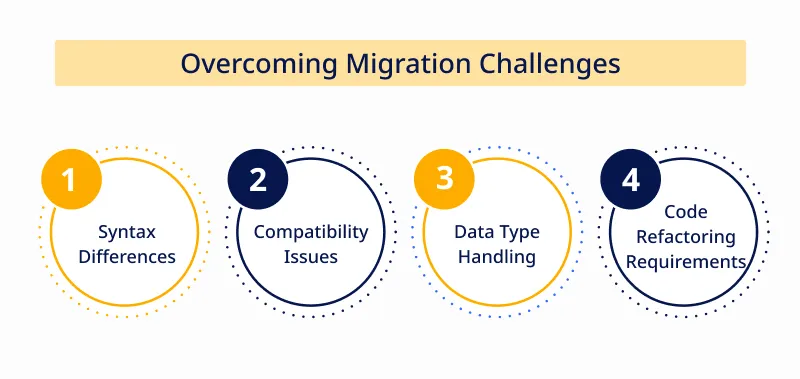
-
Automatic Migration Tools
Tools like Py4J and Jython offer automated solutions for converting Java code to Python. These tools can help simplify the migration process by automatically translating Java syntax into Python, saving time and effort for developers.
Automatic migration tools are particularly useful for handling large codebases with complex dependencies, allowing for a more efficient migration process.
-
Migration Frameworks
Frameworks such as Pyjaco and Transcrypt provide comprehensive solutions for migrating Java applications to Python.
These frameworks offer a set of predefined rules and guidelines for converting Java code to Python, simplifying the migration process and ensuring consistency across the codebase.
Migration frameworks are designed to handle common migration challenges and optimize the code conversion process, making them valuable resources for organizations undertaking Java to Python migration projects.
Also read: What Is Java Used For? 9 Things You Can Create
-
Community Forums and Support
Online community forums and discussion groups dedicated to Python development can provide invaluable support and guidance for organizations migrating from Java.
Platforms like Stack Overflow and Reddit offer spaces where developers can ask questions, share insights, and seek advice from experienced Python developers.
Community support can help organizations navigate challenges, troubleshoot issues, and stay updated on best practices and emerging trends in Python development, enhancing the success of their migration efforts.
-
Training and Skill Development
Investing in programs for skill development initiatives can prepare Java developers to transition to Python development roles.
Online courses, tutorials, and workshops focused on Python programming offer opportunities for Java developers to learn the language and familiarize themselves with its syntax, features, and best practices.
By providing Java developers with the resources and support they need to acquire Python skills, organizations can ensure a smooth and successful transition to Python development, enabling them to leverage the full potential of the language in their projects.
Incorporating these resources and tools into your Java-to-Python migration strategy can help streamline the process, minimize challenges, and maximize the benefits of transitioning to Python.
Whether you’re exploring automatic migration tools, leveraging migration frameworks, seeking community support, or investing in training and skill development, these resources can be crucial in ensuring a successful migration journey.
Our team of experienced developers will guide you through every step of the migration
Winding Up
Migrating from Java to Python is a major step towards success, but following a strategic approach can set you up for success. As we’ve discussed, it’s important to assess your reasons for migrating, plan accordingly, port over code incrementally, and leverage tools to ease the transition.
With the right preparation and practices, you can modernize your codebase while minimizing disruption. This can be done once you hire Java Developers for your project. ValueCoders has been strengthening businesses with its excellent services for years by providing them with a team of experts and excellent services.
The key is to be intentional, take small steps, and keep your developers engaged throughout the process. Though it takes time and resources, migrating to Python will leave you with more maintainable, readable code and ready for the future.
Your developers will also thank you for moving to a language that allows them to be more productive and build new features faster. With the power and versatility of Python, you can breathe new life into your legacy Java applications.

